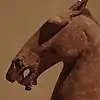Ding Huan
Ding Huan (Chinese: 丁緩) was a Chinese craftsman, and inventor who lived in the first century BC during the Han dynasty. Among the inventions attributed to him is an air conditioning system based on evaporative cooling.[1]
Purported invention of the zoetrope
In his multi-volume Science and Civilisation in China, the British scientist and historian Joseph Needham briefly describes several devices he classes as "... a variety of zoetrope, which may well have originated in China".[2] The first example he offers used an umbrella-like canopy hung over an oil lamp and provided with a vaned opening at its top, so that heated air rising from the lamp would cause it to rotate. The lower part of the canopy was in the form of a cylinder and had translucent panes with paintings of animals or men. Sufficiently rapid rotation would "give an impression of movement" to the painted figures.[2] Several later writers have misreported Needham by crediting this particular device to Ding Huan.[1][3] The only such invention Needham attributes to Ding Huan is "a 'nine-storied hill-censer' ... on which many strange birds and mysterious animals were attached. All ... moved quite naturally ... presumably as soon as the lamp was lit."[2]
Needham claims these devices "certainly embodied the principle of a rapid succession of images",[2] but it is not apparent from any of the descriptions provided that there was anything other than a procession of painted figures or carvings or cast shadows seen actually moving through space.[3] By contrast, the invention for which the name "zoetrope" was coined in the 19th century is, like the flip book, an animation device that creates an illusion of motion from a series of images showing successive phases of that motion, by rapidly presenting them to the viewer one after another in such a way that each abruptly replaces (or seems to abruptly replace) the previous one.
References
- Day, Lance (1998). "Ding Huan (Ting Huan)". In Day, Lance; McNeil, Ian (eds.). Biographical Dictionary of the History of Technology. Routledge. p. 366. ISBN 978-1-134-65020-0.
- Needham, Joseph (1962). Science and Civilization in China, vol. IV, part 1: Physics and Physical Technology. Cambridge University Press. p. 123-124.
- Rojas, Carlos (2013). The Oxford Handbook of Chinese Cinemas. Oxford University Press. p. 5. ISBN 978-0-19-998844-0.

